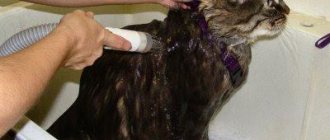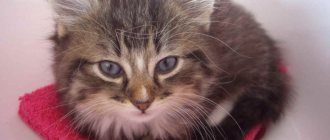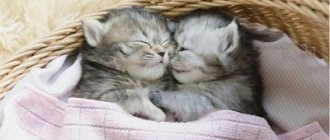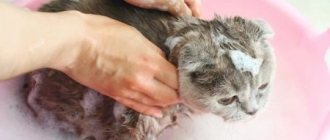All cat owners know that these are very clean animals. After eating or visiting the tray, they carefully lick their coat, and do it very efficiently.
The cat's tongue has a special structure. On its surface there are hard fibers that are located at an angle. Therefore, licking can be compared to combing with a fine-toothed comb. The cat's fur is treated with natural lubricant, which makes the fur coat attractive. When bathing, the balance is disrupted, so frequent water treatments are contraindicated for your furry pet.
Every owner understands that the animal needs to be bathed periodically, but not everyone knows how often this can be done. This procedure is recommended only in certain cases:
- in case of contamination, if the animal is walking on the street;
- once every six months to improve the appearance of the coat;
- It is necessary to bathe the cat from fleas and when infected with parasites (using special means).
But how to bathe a cat if he is afraid of water? Yes, these clean people actually have a very negative attitude towards water procedures (with the exception of some breeds). Nevertheless, sooner or later you have to resort to them. In this article we will try to tell you how to properly bathe a cat so as not to turn this process into torture for you and for the animal.
Owners need to know that the animal is accustomed to all hygiene procedures (including bathing) from a young age. Otherwise, any manipulation related to hygiene will cause a violent protest on the part of your pet.
How to bathe a cat for the first time?
So, we found out that your cat should first become acquainted with water and shampoo at a young age. It should be remembered that a kitten has a vulnerable child’s psyche. The owner’s task is not to instill in the baby a persistent aversion to water and the entire procedure as a whole. To do this, you must follow some rules. The baby’s attitude towards this procedure in the future depends on the very first bath.
A kitten should be accustomed to water from three months. Usually, before this age, his mother washes him out. However, there are exceptions to every rule. If a kitten is very dirty at the age of one month, then it can and should be bathed. You should not carry out the first procedure in the bathroom. A basin is more suitable for this, as it doesn’t look as intimidating to a baby as a huge white bathtub, and it will also be easier to keep him in the water.
You need to pour a little water so that it just reaches the kitten’s tummy. While bathing, talk to your baby in a quiet voice and call him by name. Do not wet the kitten's head from the shower; clean the fur on it with a sponge. Use shampoo for kittens, choosing it based on your pet's coat type. If you can’t purchase it, use any children’s one.
Drying your pet
The moment has come when it's time to dry. The main thing is to immediately wrap the kitten in a towel after washing so that there is no risk of getting sick. There are two types of drying:
- Leave the kitten in a warm room for 12 hours so that all the fur dries on its own. The kitten will take care of drying itself and will begin to lick itself for a long time. After all, he has special scales on his tongue that remove excess moisture.
- Blow drying is possible if the kitten is not afraid of this scary sound. Blow-drying is also better for long-haired kittens, as their fur takes longer to dry than usual and they need a little help. The main thing is to comb the coat while drying. It is recommended to dry with warm air so as not to burn or freeze your pet.
The main thing is to avoid open windows and drafts. Do not let the kitten outside while drying. Kittens are very prone to infections if their coats are wet.
How to bathe an adult cat?
If you have not taught your pet to bathe from a young age, then this procedure becomes much more complicated. However, do not think that your attempt is doomed to failure. Below we will present you with tips and recommendations from experienced owners and veterinarians who will certainly answer the question of how to bathe a cat without scratching it.
To bathe an adult animal, use dry or liquid shampoos for cats; in rare cases, it is allowed to use shampoo for people, as well as baby soap.
Which product to choose
Knowing when you can and should bathe a kitten, you should think about choosing the right product. Shampoos for kittens differ in composition from those intended for humans, in terms of acid-base balance. They come in liquid, dry and spray form.
Liquid shampoo is suitable for use for small kittens of different ages and adult pets. You need to take a little product, because later due to the abundant foam it will be difficult to wash off. If you bathe using such shampoos, your baby's fur will be soft to the touch and silky.
Dry products are an excellent choice for the owner whose pet is very afraid of the procedure. The drug is applied to the surface of the wool, after which it is combed out, and at the same time the settled dirt is removed. This product is allowed to be used more often than liquid. It does not cause dry skin, and its use does not lead to an imbalance in fat balance. Apply to completely dry skin. Allowed for use on kittens over 3 months old.
Spray shampoos are always applied to damp coat. Their peculiarity is a specific smell, so it is advised to start bathing with such products no earlier than six months.
Cleansing with dry shampoo
This is the simplest, most gentle way. What are its advantages over the traditional one? Using dry shampoo will not make your cat nervous, and your hands will remain intact.
You can use this product once every six months. In this case, the procedure will not become more complicated than regular combing. But you should know that if it is carried out on a carpet, then it will be quite difficult to clean it from the powder. After rubbing the shampoo a little into the animal's fur, comb it thoroughly.
Step #5. Choosing toys
Some cats find it helps when toys splash around with them in the bathtub. And in general, at the beginning of the bathing process, you can try to imagine everything as a game. Fill up some water in the bathtub and throw toys in there, then provoke the cat to jump after them. But it must be honestly noted that it is rare that toys can distract a cat from the unpleasant process of bathing. Nevertheless, try it - what if such a distracting maneuver suits your cat?
The authors of this video decided to interest their cat in toys.
Article continues after advertisement
Preparing for a swim
First of all, trim the cat's claws, this will protect your hands from deep and rather painful scratches. Brush the fur a little so that it doesn't get too tangled during bathing. This is especially important for long-haired animals. All matted wool is cut off if it cannot be untangled.
If a small amount of water is enough to bathe a kitten and you can get by with a basin, then what about an adult animal, which can sometimes be quite impressive in size? Keeping it in a small container is much more difficult; besides, it costs nothing for an adult and strong cat to turn the basin over. How to bathe a cat in the bathroom so that he doesn’t run away during a procedure he hates so much?
The first thing you need to do is protect your pet's ears. To prevent water from getting into them, put a cellophane cap on his head. Place a terry towel on the bottom of the bath so that your pet does not slip and feels at least a little more confident. There should be enough water so that it is just above the animal’s belly.
When starting to bathe your cat, turn off the water, as its noise additionally frightens the cat. Another important factor is water temperature. It should be slightly warm. Dip your elbow into it - it should not burn your skin. When bathing a one-year-old cat for the first time, you expose him to enormous stress, which will be very difficult for one person to cope with. In this case, at least two people will be able to hold it, since the frightened animal screams, breaks out, and scratches. It’s better to do this together, then one person holds the cat and the other washes it.
If you know your pet is too nervous, bathing becomes an additional challenge. In this case, how to bathe the cat? At this moment he scratches and even bites mercilessly. In this case, veterinarians recommend giving him a special cat sedative before the procedure. However, you should not abuse it.
Scottish fold sleeping place
The sleeping place should be quiet and calm so that the kitten can fully rest.
Choose a mattress no wider than 10 centimeters, not too soft. It is acceptable to use a sheep's wool ski mat or a special bed for kittens as a sleeping place. You can also buy or make your own house for a kitten. Its frame is cut out of thick cardboard, which can be wrapped with padding polyester, cotton wool or other soft material, and covered with natural fabric, for example, chintz sewing scraps. In such a house, a fold-eared cat can comfortably sleep.
Scottish Fold kittens are peaceful, curious and people-oriented creatures. With the right approach to education and care, you will get a devoted, intelligent and ready to help you in everything four-legged friend.
How is bathing carried out?
Before putting your cat in the bath, remove all unnecessary objects (towels, washcloths, jars, bottles, etc.) that he could get caught on. Prepare a towel in advance and open the shampoo. Place the cat in the bath, pet him, but hold him tightly, even if he tries to escape. These animals are very cunning, and as soon as your pet feels that your grip has weakened a little, he will immediately make a quick dash and run away.
Do not delay bathing, do not overdo it with the amount of detergents and the intensity of their rubbing. This animal doesn’t have so much fur that it needs to be dealt with in the bathroom for half an hour, and the more thorough the bathing, the more time it will take to bring the natural balance back to normal. Bathing should take no more than 5-10 minutes.
How to bathe a cat without water and shampoo getting into his nose, eyes or mouth? It’s very simple - don’t wash his face. He can handle this job himself just perfectly. Apply shampoo to the cat's back and rub it well. Stand the animal on its hind legs and apply it to the chest, belly, front legs and tail. Lather the shampoo with your hands. It is necessary to wash it off only from top to bottom, and this must be done carefully, because when the cat licks the fur after bathing, it can be poisoned by its residues. Wrap the animal in a towel and hold it in your arms to calm it down a little.
History of the origin of kittens
If you ask yourself how the first Scottish Fold cats appeared, you can even find out the name of the first representative of this breed. A cat named Susie was born on a Scottish farm in the 60s of the nineteenth century. She had a white fur color, a large nose, unlike today's representatives of this species, and a round head somewhat similar to an owlet. Daughter Susie immediately won the heart of Scotswoman Mary Ross when she was presented to Mary as a gift. Then this cat also gave birth to a fold-eared kitten.
However, it is not true to believe that Susie became the first representative of fold-eared cats. After all, for the first time such a feature of the ear structure in cats was noticed in China in the 18th century. The Chinese did not consider this mutation to be something good, so they did not attach much importance to it. True, those Chinese fold cats had nothing in common with the Scottish cats of our time. In truth, the first Scottish Fold kittens were far from what we are used to seeing them today. The appearance of this breed today is the result of many years of selection work. Hundreds of felinologists purposefully achieved this appearance.
It is a mistake to think that the Scottish Fold is one type of cat. In fact, there are 4 types of them, which are divided into straight-eared and fold-eared.
Fold:
- Scottish Fold - short coat;
- Highland Fold is a semi-long coat.
Straight-eared:
- Scottish Straight - short coat;
- Highland Straight is a semi-long coat.
Fold gene
It is known that the first cat of this breed was born accidentally, as a result of a genetic mutation. Unlike the Chinese, the Scots really liked these cats and began to breed the breed artificially. Through trial and error, it was discovered that the lop ear gene causes irreparable damage to the health of the animal. Having learned about this, cats were banned, and in 1971 the Scottish Fold was declared illegal.
We wouldn't see these cats today if they hadn't come to America in the 70s. There, geneticist Rosemould Peltz began a close study of the genes of these cats, and learned that the gene for lop-earedness is dominant. If it is “diluted” with another gene, it turns out that the animal’s health defects will be compatible with a full life. So, fold-eared cats began to be crossed with straight-eared ones, and as a result, kittens of both species were obtained in the same litter. This discovery helped to come up with new ways to breed the breed without compromising health. And in 1976, the Scottish Fold and Highland Fold breeds were recognized at the legislative level.
Due to the fact that lop-eared dogs were crossed with straight-eared British breeds (this breed was most suitable due to their external similarity), both were born in the same litter. Since the Scottish Straight cat ended up looking like a British cat, it was recorded as a “British cat” until 2004.
Nevertheless, scientists did not abandon the research and in the end it was proven that the straight-eared Britons are different from the “Scots”.
Differences between British and Scottish Straight cats:
- different character;
- different structure of the skull;
- The Scotsman has a lighter skeleton.
Thanks to these arguments from scientists, the Scottish Straight breed was identified in 2004.
Flea shampoo
When keeping a cat, great attention should be paid to the regular extermination of fleas. For adult animals, this is much easier to do than for a kitten: you can wear flea collars or use external drops once a month. But such products are not recommended for use on kittens - for them, the dose of chemicals may be toxic.
The most practical and most effective way to rid your baby of fleas is to bathe him with a special shampoo. Depending on the strength of the shampoo, the animal may need to be re-treated. As a rule, clear recommendations are indicated on the packaging of the product. Remember that you should not wash your cat for no apparent reason. She should only be bathed if she is really dirty.
Grooming
Due to their short hair, Scottish Shorthairs do not require complex grooming, only during the shedding period they need to be brushed, preferably with a special brush. This is necessary in order to remove dying hairs and stimulate the growth of new ones. And most importantly, while licking itself, a cat can swallow fur and fur lumps form in its stomach. As a result, the cat gags and may vomit. Sometimes the accumulated hair can lead to intestinal blockage. Outdoor cats cope with this problem by eating grass, while indoor cats have to chew on indoor plants, which is what gets them from us.
Feed manufacturers have also joined the fight against hair in the stomach. For quite some time now, food has been produced with components that prevent the formation of hair balls in the cat’s stomach and promote its natural elimination from the body. Of course, “live” green grass is healthier and more effective than such food, so in the summer you should definitely give your cat the opportunity to eat grass outside or grow it in a flower pot. Pet stores sell special pastes for removing fur from the animal's stomach. The basis of this paste is mineral oils, which envelop the hairballs in the stomach and help them pass through the feces. Cats generally happily eat the paste from their hands, but if they suddenly don’t want to, don’t be upset - just squeeze the paste (3-4 cm) onto their paw or spread it under their nose, and the cat will or may not want to, but will lick it off.
Hair, especially in long-haired cats, can also accumulate behind the lower canines where the cat cannot reach it. If this hair is not removed, then, as it accumulates, it can grow into the gums, which will lead to inflammatory processes.
The first shedding in cats occurs at 5-7 months. The coat renewal periods are from September to November and from February to April.
Highlands (Scottish Longhair cats) have a coat that requires more careful grooming, but it is not as difficult as it may seem. They do not have such an abundant cottony undercoat as Persians. In any case, it shouldn't exist. Breeders work to ensure that the coat is not long, but half-length. This is where the Highlander's coat differs from the Persian; they usually don't have problems with tangles and don't need to be brushed as often. And if, despite the softness, silkiness and resistance to matting, sometimes something sticks to their panties, then it can be quickly and accurately cut off with small scissors without any problems. In many pet stores you can buy any special brush for relatively little money. Brushes differ from each other in the shape and frequency of teeth, the material from which they are made and, accordingly, in their purpose. Therefore, it is definitely worth taking the time to choose the right equipment for your cat. If the brush is made of synthetic material, ask the seller if it electrifies the wool. Cats are not happy about static electricity running through their hair. If your cat does not like this procedure, we advise you to purchase a brush in the form of a mitten. Try to accustom your cat to brushing from childhood.
Combing should be done only according to the growth of the coat and in no case against
Particular attention should be paid to the belly and panty areas, as this is where the hair is longest and can easily become matted.
It is necessary to comb the tail with great care, since a large number of nerve endings are concentrated in it, which is why the scratching process can cause discomfort to the animal. The abdominal area is also very carefully combed.
Another way is to pet the cat with a damp hand so that dead hairs stick to your palm.
The abdominal area is also very carefully combed. Another way is to stroke the cat with a damp hand so that the dead hairs stick to the palm.
By carefully examining the coat while combing, you can make sure that your pet does not have parasites. Yes, yes - a very common phenomenon even in purebred domestic cats - external parasites - fleas, ticks. Their bites are painful and cause a lot of trouble for animals; it is especially difficult for long-haired Highland cats.
What should you not do while swimming?
As you can imagine, bathing a cat, a procedure that takes only a few minutes, is quite difficult for both the animal and its owner. Therefore, it is necessary to minimize possible irritants:
- Do not open the tap at full capacity.
- The shower should not be turned on at full power.
- Do not use dog shampoo or dishwashing detergent to wash your pets.
- There is no need to pour shampoo from the bottle directly onto the coat, especially dry hair.
- It is strictly forbidden to stuff the animal's ears with cotton - it can cause serious irritation.
Relationship with the toilet
If you take a kitten from a breeder, then the baby, as a rule, already knows that there is a special place for the toilet. When he appears in the house, you should immediately show him the tray, and the smart animal will not cause you problems, leaving puddles in the wrong places
Pay attention to the toilet filler. It is better if at first it is the same as in the previous house
The Scots prefer silica gel, which they love to dig for, enjoying the rustling sounds. In addition, it perfectly eliminates all odors. You can also choose sawdust pellets, but they require more frequent replacement.
If the baby is not yet familiar with the cat litter box, you need to immediately start raising the kitten until he gets used to relieving himself in places convenient for him. You should immediately explain to your pet that there is a special corner for the toilet.
A place for the tray must be chosen that is easily accessible, but quite secluded. Many cats like to do their business without attracting too much attention to themselves. A bathroom, toilet, or closet is best suited for this purpose. Just remember to always leave the door slightly open. You can choose a corner in the corridor.
If you categorically refuse to use the tray, changing the filler or its location often helps.
What to do after swimming?
After bathing your cat, you need to dry it thoroughly with a towel, since cats get very cold after such a water procedure, especially if the apartment is not very warm. Many owners consider it lucky if the cat allows him to be warmed in a towel for at least five to ten minutes. Then the animal will most likely break free and begin to lick its coat on its own.
Pre-cover all surfaces where your pet can sit down to lick with towels. They will absorb moisture, and your sofas and carpets will remain stain-free. If your cat continues to tremble violently within five minutes, try to dry it with a hairdryer to avoid catching a cold or even pneumonia.
You already know how to bathe a cat. Now it’s worth talking about combing the fur. When the cat stops licking his fur, pick him up and brush him with a wide-toothed brush. After bathing, the coat becomes very brittle, so combing must be extremely careful.
Prevention
To prevent your straight-eared cat from being overcome by diseases, including infectious ones, it is important to get vaccinations on time, feed her properly and monitor her appearance and behavior. Many diseases can be prevented by providing proper nutrition, proper care and attention to the animal.
From the list of everything that is necessary to provide proper care, it is first of all important for the cat owner to ensure that the necessary vaccinations are completed on time. This is especially important if your Scottish Highlander has the opportunity to roam freely and interact with other animals.
Thus, mandatory rabies vaccinations are carried out as early as 3 months. Having a passport indicating your vaccinations will allow you to obtain the necessary certificates and travel by plane or train absolutely legally.
It is necessary not only to know the symptoms that may indicate that your Straight is sick, but to be regularly examined by a veterinarian. The specialist will determine the cat’s condition, and in case of illness, he will advise what and how to treat it, what to feed and how to care for it.
And a few more tips
- Under no circumstances should you yell at your pet while bathing; remember that he is under extreme stress; calm him down in a quiet voice.
- Rinse the fur very thoroughly after shampoo - low-quality products can be toxic to the animal.
- If the cat gets dirty with something oily, lubricate the spot with butter before bathing, massage it a little and blot it with a paper napkin or towel.
- When removing fleas using a special shampoo, first wet its neck so that they do not run onto the animal's head.
Permissible procedure frequency
For almost every cat, bathing is stressful; they do not like water. The thing is that cat fur creates an air cushion over the skin, which provides the kitty with a feeling of comfort and warmth. Therefore, by wetting a cat's fur, you deprive it of its usual comfort.
A healthy cat should be washed no more than once every two months. Excessive bathing with shampoo can only cause harm: dry out the skin and cause irritation. Representatives of long-haired breeds need to be washed a little more often, as their coat requires more careful care.
Raising a kitten
Scottish Fold kittens are famous for their calm disposition, they are intelligent and very friendly. The kitten quickly gets used to the new place, the owner and his family members, and gets along well with other pets. From the very first days of your baby’s stay in your home, you need to firmly define what he is not allowed to do. Climbing onto a table, into a closet and other undesirable places, tearing up walls and climbing curtains - this must be stopped.
You need to say “no” loudly and strictly and give the kitten a little slap, but you can’t hit him. There will be no benefit from this, but on the contrary, then he will grow into an aggressive and timid animal. Scottish Fold kittens need communication, you need to play and talk with them. Without proper attention, you will end up with an unsociable and overly reserved cat.











